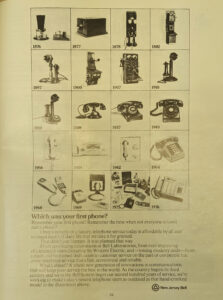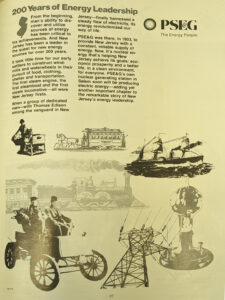Lianne Chapin and Grace Wang
Thousands of historical markers litter the streets, sidewalks, parks, and fields of New Jersey, commemorating its hundreds of years of history. Many of these markers were erected by the state of New Jersey itself through two big waves of marker-based commemoration – one in the 1930’s and one in the 1960s. 1 In some parts of the state, it’s hard to walk a block and not see a sign announcing a stop on Washington’s route to Morristown or a plaque remembering a heated Revolutionary exchange. Many of these formal markers represent the state’s relationship to its Revolutionary War past, representing a strong state-level effort to remember New Jersey’s place in the Revolution, but what has commemoration looked like for everyday New Jerseyans?
From the “Crossroads of the Revolution” license plate cover still sitting in the trunk of your grandpa’s Oldsmobile to the star-spangled Betsey Ross ceramic figurine in the attic, to the cardboard tricorn hat you made in second grade, the answer lies in the everyday objects infused with the “spirit of ‘76” that New Jerseyans use to bring closer a distant history. 2 As with the official historical markers, many of these commemorative objects came about for the 1976 Bicentennial, representing America’s material prowess and bringing the Bicentennial’s celebrations and commemorations to New Jerseyans who wouldn’t otherwise feel connected to them. We see on almost every street corner how a state commemorates the revolution, but how does a family? How does a consumer? How does a company? Looking back at a legacy of commemorative objects, the rhetoric of these ownable pieces of commemoration tells a story of material engagement with history, of democratization, and of history claimed at the individual level.
Commemorative rhetoric makes a star-spangled appearance in Bicentennial-era corporate advertisements, adding a Bicentennial flair to companies’ existing products. In the New Jersey Chamber of Commerce’s magazine, “The Festival of the Ten Crucial Days,” New Jersey Bell Telephone Company features an advertisement with the tagline “Which was your first phone?” The ad boasts that “as the country begins its third century,” Bell is beginning their “second hundred years of service,” highlighting that during this historical moment for America, the Bell Telephone company is also celebrating their longevity. 3 Similarly, the energy company PSE&G includes an advertisement in the magazine featuring the heading “200 Years of Energy Leadership.” Interestingly, this tagline alludes to not PSE&G but to New Jersey history, as the ad explains, “New Jersey has been a leader in the quest for new energy sources for over 200 years.” With this ad PSE&G seems to leverage the New Jersey connection to add a historical flair to their product, despite the fact that, as the finer print acknowledges, their company was founded in 1903. 4


Alongside advertisements, manufacturers also took the opportunity to produce Bicentennial-themed items like commemorative plates and other memorabilia, now found in attics across America. 5 These items facilitated commemoration by giving people a tangible means to “own” the bicentennial and connecting them to an otherwise inaccessible past. 6 As the American public was confronted with commemorative objects in storefronts and companies’ history-forwarded advertising in magazines, corporate Bicentennial initiatives might have just served to make engagement with history just a little more accessible.
But, of course, corporations were not the only entities who engaged in Bicentennial initiatives. On the local level, community members in the City of Trenton used the occasion to invest in their city’s public landscape. For example, the Trenton Bicentennial Committee’s aptly named “Beautification” sub-committee organized an initiative to plant tens of thousands of “beautiful bulbs” to make the city “prettier than a picture” for the occasion. This initiative was advertised to locals in Trenton, who, with “a contribution of $5.00 or more” could have the blooms planted in their name. 7 The Director of Secondary Education on the Trenton Board of Education, for example, personally donated $25 to Trenton High School to contribute to its floral “beautification.” 8
Local Bicentennial projects not only served the purpose of revitalizing the landscape for the event — they also allowed organizations to undertake long-awaited maintenance efforts. However, it would be remiss to say these efforts did not face their challenges. Regarding the restoration the Douglass House in Trenton, James Sears of the Mercer County Cultural and Heritage Commission, the organization that provided funding for the project, expressed in a letter to the Trenton Bicentennial Committee that he was not altogether pleased that the funds went to the purchasing of new tools instead of “lumber, paint, and nails which would go into the permanent structure.” 9 The Commission’s prioritization of a landmark’s historical significance over its long-term preservation presents an example of how conflicting local agendas posed challenges during Trenton’s Bicentennial planning process.
From beautification flower bulbs to Bicentennial maintenance projects to Bell telephones, New Jerseyans at the time of the Bicentennial brought the history to themselves by engaging with it through these commemorative objects. Though the collection of Bicentennial objects may seem materialistic and the advertisement and distribution of them may come off as purely profit-seeking, commemorative plates, calendars, figurines–even t-shirts–offered a low-effort way to meaningfully engage with the history of the Revolution, providing an entry point into commemoration for those with less of an immediate connection to it and allowing a wider variety of people to participate in commemorative efforts.
When organizations like the Daughters of the American Revolution tend to spearhead commemoration of the Revolution, the majority of Americans who cannot trace their lineage back to the 18th century can feel left out of the commemorative tradition. Buying a three dollar license plate cover or donating five dollars for beautification bulbs, is not only significantly easier, but accessible to more Americans, democratizing the practice of commemoration and allowing people to own the Bicentennial who may not have the opportunity to do so otherwise.
Even in Trenton, the buy-centennial provided opportunities not only for consumers to engage with the Bicentennial, but for businesses as well, allowing them to use the Bicentennial’s commercial appeal to connect with consumers on a new level. At a time when manufacturing was dwindling and “Trenton Makes, the World Takes” was feeling less and less like a point of city pride and more like a relic of the past itself, highlighting local businesses in the “Festival of the Ten Crucial Days” magazine provided an opportunity to take pride in local institutions and encourage Trentonians to do so. 10
Getting everyday Americans excited about distant history is hard, especially when they feel disconnected from it or like they can’t celebrate something their ancestors didn’t take part in. Though it may not seem so at first glance, their participation in commemorating the Revolution, whether their first time was at the Bicentennial, or it is yet to come during the Semiquincentennial, or they started during any of the July 4ths in between, they participate in America and will shape its future, so knowledge of its past is crucial. If a commemorative lunchbox or star-spangled license plate can capture the engagement of someone who would otherwise be watching from the sidelines, it is just as important of a commemorative force as every plaque, history book, or reenactment. We can’t expect everyone to feel invested in America’s future if we don’t allow everyone to feel connected to its past — however many commemorative bumper stickers it takes.
- “NJ Department of State – Historical Commission – Historical Markers in New Jersey.” Accessed 10 May 2024. https://nj.gov/state/historical/historical-markers.shtml. ↩
- “Ford Museum – Artifact Collections – Bicentennial Artifacts – Figurine.” Accessed 10 May 2024. https://www.fordlibrarymuseum.gov/museum/artifactcollectionsamples/Catagories/Bicentennial/Figurine.html. ↩
- “Which Was Your First Phone?” in “The Festival of the Ten Crucial Days,” New Jersey Chamber of Commerce, Trenton Bicentennial Committee Collection, Trentoniana Room, Trenton Free Public Library. ↩
- “200 Years of Energy Leadership,” in “The Festival of the Ten Crucial Days,” New Jersey Chamber of Commerce, Trenton Bicentennial Committee Collection, Trentoniana Room, Trenton Free Public Library. ↩
- “Champale Celebrates the Bicentennial with this NC Wyeth Commemorative Plate” in “The Festival of the Ten Crucial Days,” New Jersey Chamber of Commerce, Trenton Bicentennial Committee Archive, Trentoniana Room, Trenton Free Public Library; “Ford Museum – Artifact Collections – Bicentennial Artifacts.” Accessed 29 March, 2024. https://www.fordlibrarymuseum.gov/museum/artifactcollectionsamples/Catagories/Bicentennial/PopBottle.html. ↩
- Wendy A. Woloson, Crap: A History of Cheap Stuff in America (Chicago: The University of Chicago Press, 2020), 228. ↩
- “Keep a Good Thing Growing Donation Form” (Trenton Bicentennial Civic Improvement Subcommittee, March 26, 1976), Box 2, Folder 2, Trenton Bicentennial Committee Collection. ↩
- Dalba Brilliantine to Perlee Solon, “Trenton Board of Education Regarding Trenton Bicentennial Committee,” June 16, 1975. ↩
- James M. Sears to Mark Brown, “Mercer County Cultural and Heritage Commission to Trenton Bicentennial Committee about Douglass House Restoration,” January 14, 1975, Box 1, Folder 11, Trenton Bicentennial Committee Collection. ↩
- Chelsey Johnstone, “Slogan of the City: Trenton Makes – The World Takes,” TrentonDaily, October 2, 2020. Accessed 10 May 2024. https://www.trentondaily.com/slogan-of-the-city-trenton-makes-the-world-takes/. ↩

